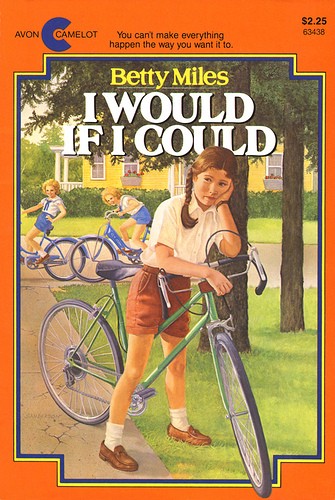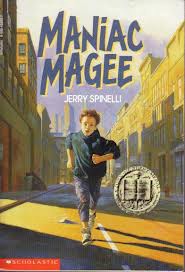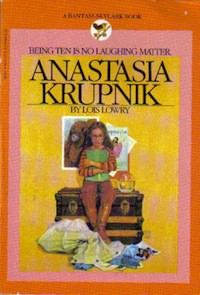The Books of Our Childhood Summers
by Jen Doll

I have summer fever. To me, this seasonal state involves the desire to sit poolside, a book next to me opened to damply thumbed pages, the scent of chlorine and coconut sunscreen in the air, and a cold lemonade within reach creating a puddle of condensation where it rests. Maybe it’s not a pool. I could be lying upon the sand with an ocean view, or reclining on a hammock hung on a porch, or even indoors in the comfort of air-conditioning on the hottest of summer days. Wherever I am I’m eating a popsicle, and, most likely, I’m reading a book.
There are a great many excellent summer reads, but to me, some of the most moving books of summer are the ones we read way back when we were kids on summer vacation. These stories may be five or 10 or 20 years old, or more, yet they still manage to take us right back to that childhood sense of summer, and wonder, when the days stretched out long and full of possibility, when the sun didn’t go down until 9 p.m. and we could roam free in our neighborhoods, ruling our small worlds, until then. Anything could happen by day, but by night, I’d be tucked in bed with a good book, which I could read with impunity into the wee hours because there was no school the next day. I’m a big believer in re-reading, particularly books we experienced at some long-ago time in our lives, because the power of those stories is not just in their words. They are transportive, letting us remember, re-live, and compare who we were then with who we are now.
Those of us who were avid readers in childhood — a lot of us here, I’m willing to bet — surely have at least one of such book in the deepest darkest caverns of memory (where in my imagination it smells a bit like summer camp). At the Hairpin, we have several. For Emma, it’s a tie: “I reread books a lot as a kid, and I think I made it through Maniac Magee five or six times,” she says. “It’s absolutely mythical and over-the-top, and it involves a made-up baseball pitch called the ‘stop-ball,’ in which the ball just stops moving before it hits the plate. I think Maniac lives for a while in a buffalo range.” She also “repeatedly devoured the Betsy-Tacy (& Tib) series,” which she calls “VERY summer. I wanted to live on Hill Street.” So did I, and I wanted the Rays to adopt me, if only temporarily, so I could eat Mr. Ray’s onion sandwiches and go to Murmuring Lake for the summer.

Hairpin Publisher John Shankman was into The Boxcar Children: “Reading them was like a hot knife cutting through butter. Besides the sense of adventure, I remember the teamwork. I’ll never forget the cover of the first book in the series too for some reason (of the edition I read, at least).” And Jia liked the Anastasia Krupnik books, by Lois Lowry (yes, these were wonderful!). “Anastasia was one of the most self-directed, independent and curious characters in children’s fiction that I ever encountered ,” she says. “She was Harriet the Spy in the suburbs, seizing upon every weird opportunity that presented itself (charm school, personal ads, strange neighbors that may or may not be Gertrude Stein). I was in third or fourth grade when I read those books, and so although the character was a bit older than me, she made me feel like I had this ally as my summers started to split themselves between textbook dodgeball-in-the-park friend stuff and my own, increasingly weird pursuits of self-fascination where I’d spend hours writing, exploring, eavesdropping on strangers at the public gazebo.”
Our childhood reads weren’t just entertainment. They were also our friends.
The book that reminds me of summer on the verge of 10 was one that took me a while to track down. Sometimes we remember key plot points, characters, and the way the stories made us feel, but vital details like title and author have been left behind. In the case of this book, I had the faint recollection that it was about a girl learning to ride a bike, that she was staying with her grandmother and aunt for the summer, that the community pool was closed due to the polio epidemic, and that in the end she conquers her bike fears and rides off into the sunset for ice cream with her friends. With the help of the Internet and a series of Google searches, I found it. It’s called I Would If I Could, and it’s by Betty Miles, who also wrote The Trouble With

Thirteen and Maudie and Me and the Dirty Book. I quickly ordered it on Amazon, though the cover was different than the one I remembered. An Authors Guild BackinPrint edition, it has an early ’90s vibe which what I assume is a stock photo featuring a girl in a dress and clunky shoes, riding past what might be a palm tree (main character Patty was in Ohio for goodness sakes!) on a neon bike. What’s inside is thankfully the same as the book I read when I was around the same age as Patty, though. That book cover showed her in braids, an expression of disappointment on her face as she wrangles her new racing bike while her frenemies the twins ride by in matching sailor suits on their perfect cycling machinery. At the top of the book cover is the message, “You can’t make everything happen the way you want it to.” (I notice the price of that book was $2.25. Remember those days?)
Re-reading this book, which I did one night a week or two ago, brought it all back, an unexpected, delicious summer treat, not unlike reuniting again with the old friends of summer camp and finding them older, wiser, maybe, but pretty much the same. There’s Patty, timid but hoping for courage, and her grandmother, a great cook and also sweet and kind, including to an out-of-work man who comes looking for work and food. Mary Ann, Patty’s best friend, is fiercely loyal. Patty’s aunt only wants the best for her niece, though her gift of Patty’s bike causes trouble. The twins, well, they’re not all bad. The message of the book, too, was good for then, and it’s still true now: If you can get over your fears, you can accomplish a lot. Though you can’t make everything happen the way you want it to, what does happen can be even better than what you thought you did want. Let that spin around in your adult brain as you eat a popsicle. It’s still true!
But now I’ve read that book (plus/minus is that childhood reads are short) and need another. So, what are the favorites read back then that are worth looking at again now, and why? Please share. Let’s get a summer childhood reading list going. I need to take the edge off my summer fever.
Jen Doll is a regular contributor to The Hairpin.